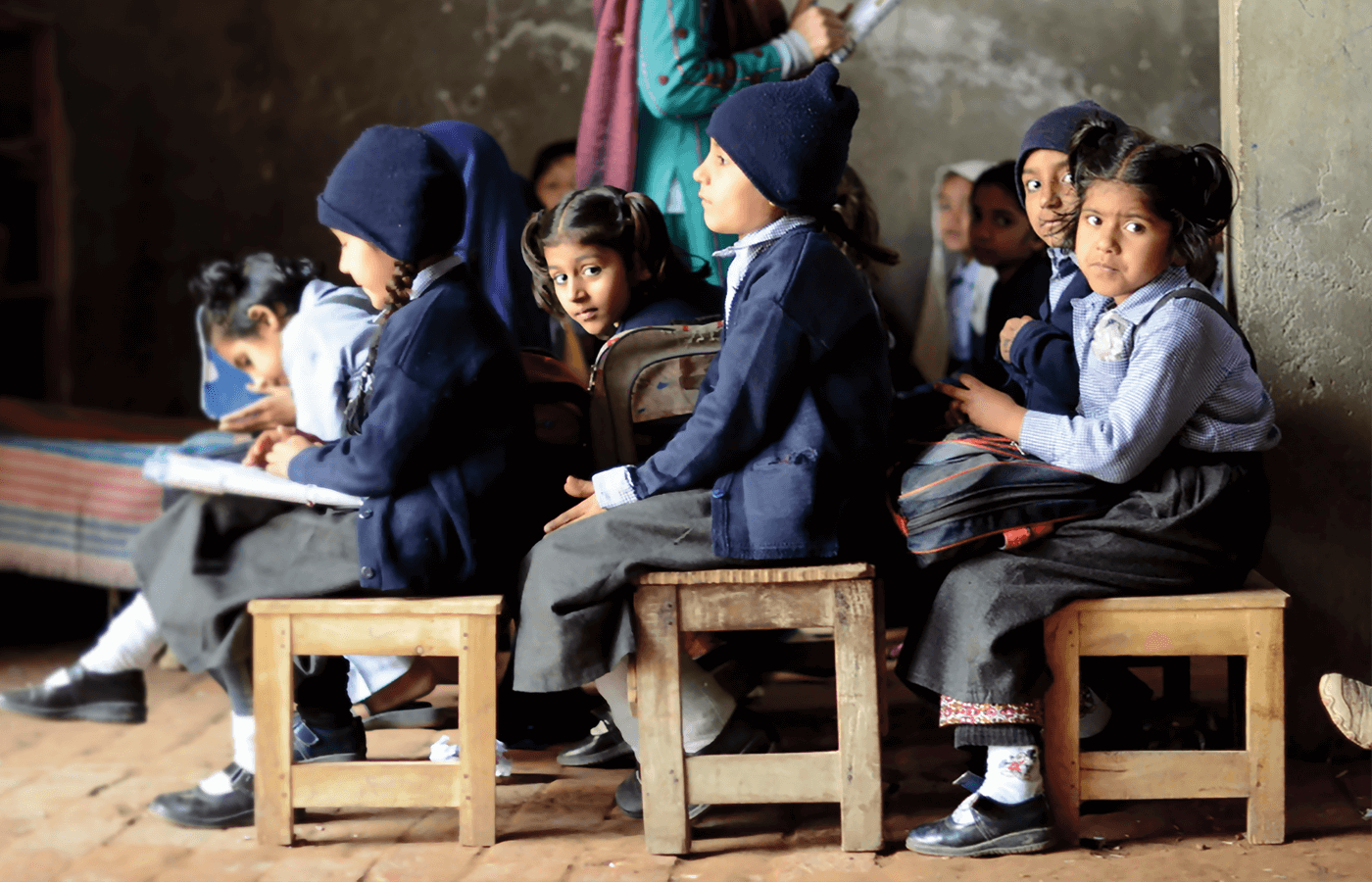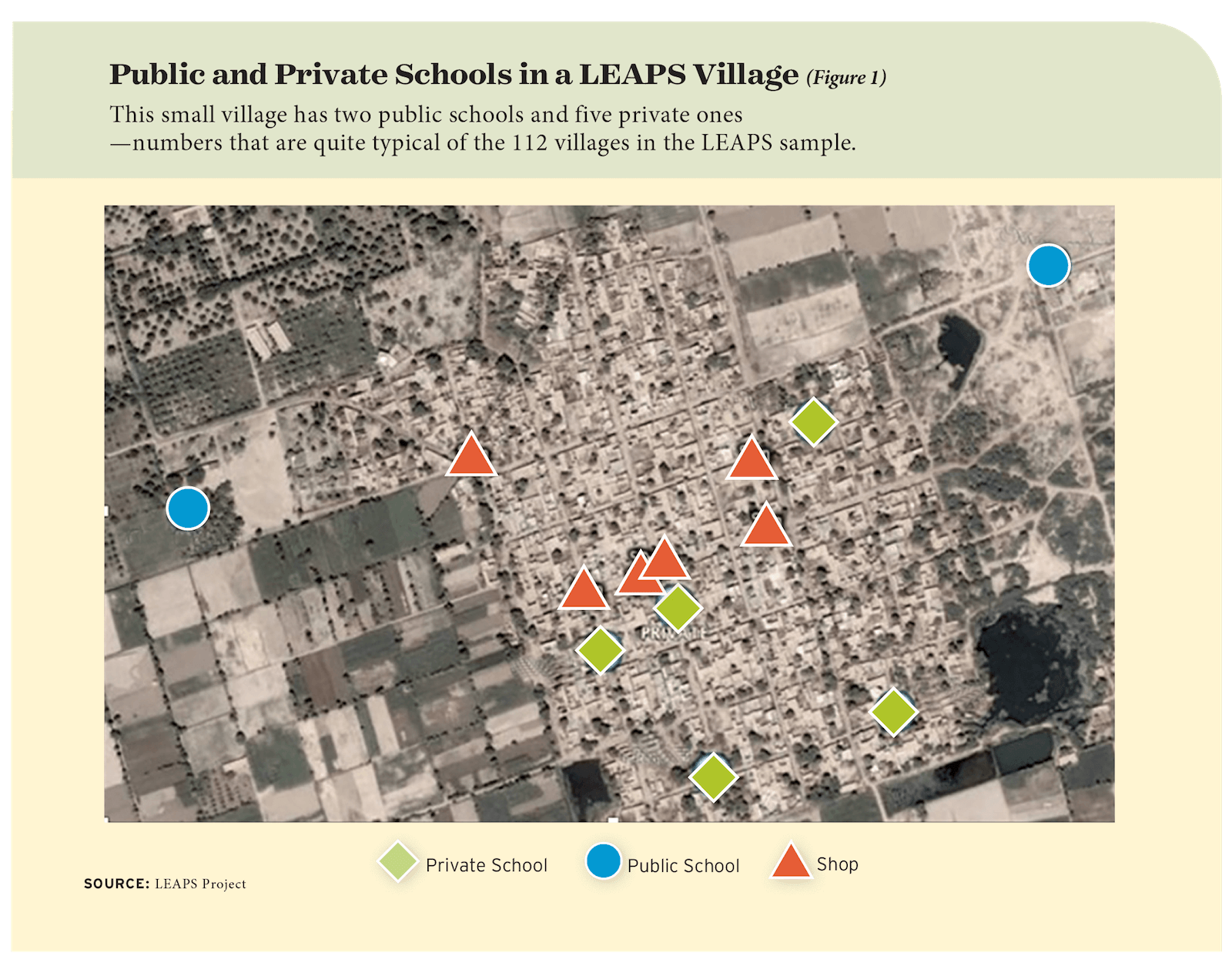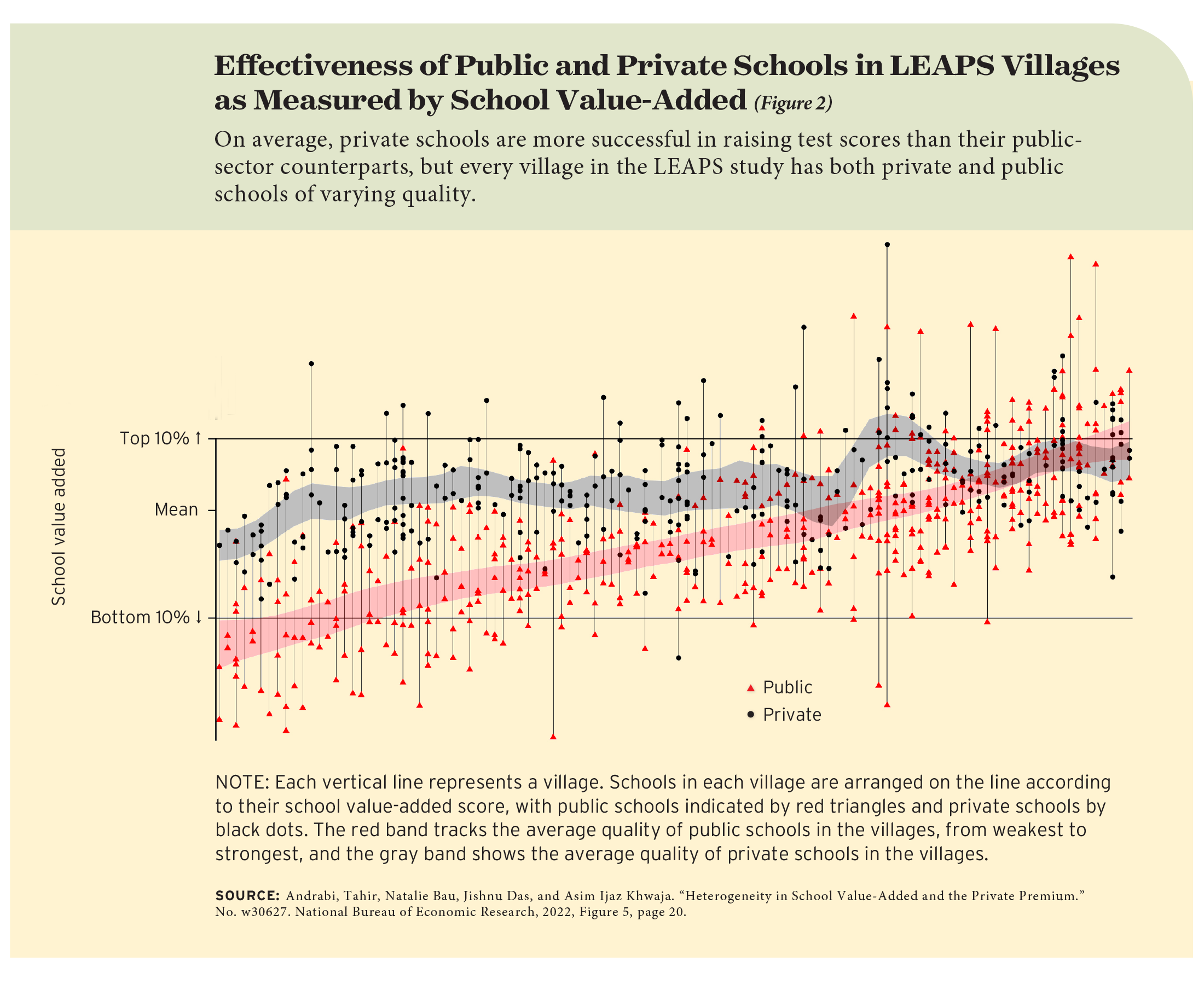
In the United States, 9 percent of K–12 students attend private schools, but in low- and middle-income countries, private schools account for 20 percent of all primary enrollment and are rapidly gaining ground. In Pakistan, the number of private schools rose to more than 70,000 by 2015, up from 3,000 in 1982; by 2015, these schools educated 34 percent of Pakistani children enrolled in primary schools. In contrast to private schools in the United States, Pakistan’s are highly affordable, and the majority are secular.
This growth in private schooling comes at a unique moment in global education: low-income countries have managed to substantially increase enrollments at all levels of schooling, but they have yet to improve what children learn. For instance, the unprecedented speed at which primary (and now secondary and college) enrollment has risen in low-income countries dwarfs the historical experience of today’s rich countries. Yet, in countries such as India and Pakistan, when children are tested at the end of 3rd grade, one-third of them cannot subtract two-digit numbers, less than a sixth can read a simple sentence in English, and less than half can read a simple sentence in the vernacular language, Urdu. Across low-income countries, test scores are so low that the situation has been dubbed a global learning crisis by organizations such as the World Bank and UNESCO.
The growth in private schools, coming at the same time as the shift in focus from enrollment to learning, has polarized the education community in low- and middle-income countries. Some people favor heavily regulating or even shutting down private schools, based on the belief that they provide substandard education to children of parents who are unable to assess the quality of schools; others believe that private schools should be encouraged and indeed subsidized through the public purse because they provide a valuable option in places with failing public schools. Missing from this debate is a detailed empirical picture of what the growth of private schools means for education markets more broadly. How does the rise in private schooling affect demand for schools in both the private and public sectors, and how do schools respond to any changing demand? Does more competition increase quality? Should governments maintain their focus on improving the quality of public schools, alleviate constraints on private alternatives—or perhaps do both?

Learning from the LEAPS Project
Research from the Learning and Education Achievement in Pakistan Schools project, or LEAPS, sheds light on these questions and holds implications for public policy in Pakistan and around the globe. To understand how the growth of private schools was transforming the education landscape in low-income countries, in 2003 I teamed up with Tahir Andrabi of Pomona College and Asim Ijaz Khwaja of Harvard University to launch the LEAPS project, a study of all the schools in 112 villages in the province of Punjab. The province has more than 100,000 schools, of which 60,000 were private in 2015. (By comparison, the state of California, with the largest public-education system in the United States, has about 10,000 public schools.) The villages in the LEAPS project were selected from those that had at least one private school in 2003; these villages are larger and somewhat wealthier than the average village in Punjab, which in turn has the lowest poverty rate of all Pakistani provinces. At the time the project began, about 60 percent to 70 percent of the province’s rural population lived in villages with at least one private school. Between 2003 and 2011, the LEAPS team tracked more than 800 schools in these villages, interviewed more than 1,000 principals and 2,000 teachers, and tested more than 70,000 children to gauge their foundational skills in literacy and numeracy.
The high concentration of private and public schools in Punjab Province has transformed education markets there. Figure 1 shows a village in the LEAPS sample. It took me (and two young children) 15 minutes to traverse the village, yet it has five private and two public schools. Data gathered by the LEAPS team show that in 2003, the average fee for private schools in rural Punjab was equivalent to about $1.50 a month, or less than the price of a cup of tea every day. The number of schools in the village portrayed here is typical of the sample—in fact, the average LEAPS village in 2003 had 678 households and 8.2 schools, of which 3 were private.
The proliferation of private schools in Punjab has enabled such considerable school choice that, once we account for urban areas, some 90 percent of children in the province now live in neighborhoods and villages like the one illustrated in Figure 1. Such “schooling markets” are not just a Pakistani or South Asian phenomenon. Schooling environments in Latin America and parts of Sub-Saharan Africa also offer extensive variety for local families.
One question widely examined by education researchers is whether children in private schools learn more than those in public schools. Is there a private-school “premium” that can be measured in terms of test results or other metrics? One impediment to answering that question is that children enrolled in private schools are not randomly drawn from the local population, and researchers often cannot convincingly correct for this selection problem. In my view, though, a larger obstacle is that the concept of an “average” private-school premium is elusive when families can choose from multiple public and private schools and the quality of schools differs vastly within both sectors. Comparing a high-performing public school to a low-performing private school will yield a very different result than comparing a high-performing private school to a low-performing public school.
The LEAPS research team looked at this question in a study published in 2023. We defined school value-added as the gain in test scores in Urdu, math, and English that a randomly selected child would experience when enrolled in a specific school. The team found that the value-added variation among schools was so large that, compounded over the primary school years, the average difference between the best- and the worst-performing school in the same village was comparable to the difference in test scores between low- and high-income countries.
Figure 2 shows what this variation implies for estimates of private-school effectiveness. Each vertical line in the figure represents one of the 112 LEAPS villages. Schools in each village are arranged on the line according to their school value-added, with public schools indicated by red triangles and private schools by black dots. The red band tracks the average quality of public schools in the villages, from weakest to strongest, and the gray band shows the average quality of private schools in the villages. The private schools are, on average, more successful in raising test scores than their public-sector counterparts. As is clear, however, every village has private and public schools of varying quality, and the measure of any “private-school premium” depends entirely on which specific schools are being compared. In fact, the study shows that the causal impact of private schooling on annual test scores can range from –0.08 to +0.39 standard deviations. The low end of this range represents the average loss across all villages when children move from the best-performing public school to the worst-performing private school in the same village. The upper end represents the average gain across all villages when children move from the worst-performing public school to the best-performing private school, again within the same village.

Parents’ Choices
The relevant question, then, is not whether private schools are more effective. The questions are: How well are parents equipped to discern quality in a school—public or private—and choose the best one for their children? And can policy decisions affect these choices?
As to the first question, the team found that parents choosing private schools appear to recognize and reward high quality. Consequently, in the LEAPS villages, private schools with higher value-added are able to charge higher fees and see their market share increase over time. In contrast, parents choosing public schools either have a harder time gauging the school’s value-added or are less quality-sensitive in their choices. This is particularly concerning in the case of students enrolled in very poorly performing public schools where after five years of schooling they may not be able to read simple words or add two single-digit numbers.
Given that parents who opt for public schools appear to be less sensitive to quality, one reform instrument often supported by policymakers is the school voucher, whereby public money follows the child to the family’s school of choice. The idea is that making private schools “free” for families will allow children to leave poorly performing public schools in favor of higher-quality private schools. This strategy assumes that parents, when choosing among schools, place significant weight on the cost of the school, manifest in its fees. What’s more, one may reasonably expect that such “fee sensitivity” will be higher in low-income countries and among low-income families. Yet a 2022 analysis of the LEAPS villages showed that a 10 percent decline in private-school fees increased private-school enrollment by 2.7 percent for girls and 1 percent for boys. From these data we estimated that even a subsidy that made private schools totally free would decrease public-school enrollment by only 12.7 and 5.3 percentage points for girls and boys, respectively. This implies that most of the subsidy, rather than going to children who are leaving public schools, would be captured by children who would have enrolled in private schools even without the tuition aid. Further, most of the children induced to change schools under the policy may come from high- rather than low-performing public schools, limiting any test-score gains one might expect.
One alternative to trying to move children out of poorly performing public schools is to focus on improving those schools. A LEAPS experiment that my co-authors and I published in 2023 evaluated a program that allocated grants to public schools in villages randomly chosen from the LEAPS sample. We found that, four years after the program started, test scores were 0.2 standard deviations higher in public schools in villages that received funds than in public schools in villages that did not. In addition, we observed an “education multiplier” effect: test scores were also 0.2 standard deviations higher in private schools located in grant-receiving villages. This effect echoes an economic phenomenon that often occurs in industry—that is, when low-quality firms improve, higher-quality firms tend to increase their quality even further to protect their market share. In the LEAPS villages, the private schools that improved were those that faced greater competition, either by being physically closer to a public school or by being located in a village where public schools were of relatively high quality at the start of the program. The same was true of private schools in villages where the grants to the public schools were larger.
The education multiplier effect increases the cost-effectiveness of the grant program by 85 percent, putting it among the top ranks of education interventions in low-income countries that have been subject to formal evaluation. But beyond that, accounting for private-school responses also changed the optimal targeting of the policy. For instance, our analysis shows that if policymakers consider test-score increases in public schools only, a policy that divides resources equally across villages also maximizes test-score gains; there is apparently no trade-off between equity and effectiveness. Once private-school responses are considered, however, equal division of resources exacerbates existing inequalities in learning among villages. This implies that a government that values equity should distribute more resources to villages with poorly performing public schools.
Implications for Policymaking
With 90 percent of Pakistani children living in neighborhoods with multiple public and private schools, the days when government could formulate policies that affected only public schools are long gone. The same is true of many other low-income countries where parents also have significant school choice, ranging from Chile to India. Every policy will have an impact on both public and private schools, even if a policy only targets public schools. Policymakers can choose to ignore these additional effects, but to do so is to miscalculate the policy’s full impact. Our studies are still too premature to help factor parental and private-school responses into the design of policy. A key insight from the LEAPS research is that there is significant variation among schools in terms of performance and among parents in terms of their preferences for quality. A policy to improve public schools can lead to an education multiplier effect in one context but cause private schools to exit in another. A broad understanding of the dynamics of education markets, such as parents placing a very heavy weight on physical distance to school in their choices, can shed some light on this variation. Yet the data requirements to make detailed predictions about how policies will play out in specific settings may be too onerous, at least for now.
How then to proceed? Three broad principles are emerging from the LEAPS project.
First, there is little evidence that parents choosing to send their children to private schools in low-income countries are being fooled or hoodwinked into receiving a substandard education. On the contrary, the parents choosing private schools seem to be more informed and better able to reward school quality. The bigger problem is the substantial population of children enrolled in very low-performing public schools, even when there are better public schools nearby. Unfortunately, policies that seek to move children from public to private schools by means of vouchers may end up spending a lot of money on children who were already going to private schools. What’s more, the test-score gains from such policies may be limited if most of the children who do switch from a public to a private school come from higher-performing public schools. Indeed, a 2022 study by Mauricio Romero and Abhijeet Singh showed that both of these dynamics play out in India’s Right to Education Act, which established one of the world’s largest voucher schemes. Subsidizing private schools in a way that consistently improves test scores by moving children out of low-performing public schools remains an elusive goal.
If we cannot move children out of low-performing public schools, the alternative is to improve those schools. The second principle, then, is that governments should maintain a focus on improving the quality of public schools. Results of the first generation of efforts to do so in low-income countries were mixed at best, but studies of newer reform efforts that emphasize improved pedagogy, incentives, teacher recruitment and training, and school grants are all showing positive results. A 2021 study by Alex Eble and colleagues, for instance, showed dramatic improvements in test scores in The Gambia with an intervention that used a variety of strategies: hiring teachers on temporary contracts, making changes in pedagogy, monitoring teachers, and giving them regular feedback. Again, the benefits of these policies may extend beyond the public schools they target. In schooling markets, the education multiplier effect will create positive knock-on effects for private schools.
Third, leaders should consider an entirely different class of policies. These are policies that do not privilege either the public or private sector but acknowledge that both parents and schools face constraints and that alleviating these constraints can lead to significant improvements in both sectors, regardless of the preferences of parents or the cost structures of schools.
Studies by the LEAPS team present two examples of such policies. In the first, the team provided parents and schools with information on the performance of all schools in a village—public and private—through school “report cards.” We found that this intervention improved test scores in both public and private schools and decreased private-school fees. The policy, in this case, pays for itself and has been recognized as a global “great buy” by a team of education experts.
As a second example, in 2020 the LEAPS team provided grants to private schools, but in some villages, we gave the grant money to a single school and in others to all private schools in the village. We found that in the first scenario, the school used the money to upgrade infrastructure and expand enrollment but with no resulting improvement in test scores. However, when all the private schools in a village received a grant, schools expanded enrollment and increased student test scores. These schools anticipated that simultaneous capacity improvements by all the private schools would lead to a price war, driving profits to zero, so they focused largely on test-score improvements to maintain profit margins. In both scenarios, the combination of boosted enrollment and higher fees increased the schools’ profits. These increases were large enough that, had the schools taken the money in the form of loans, they would have been able to repay them at interest rates of 20 to 25 percent or more. Finally, the schools improved even though the grant terms did not explicitly require them to—showing that the market generated the incentives for improvement without additional monitoring and testing by external parties, which in Pakistan has proven to be both costly and difficult.
These interventions leverage the fact that many children in Pakistan and around the globe now live in neighborhoods with multiple public and private schools. In these environments, progress relies on alleviating broader constraints in the education market rather than focusing on specific schools or school types. Moving beyond “public versus private,” we now need policies that support schooling markets, not schools—the entire ecosystem, not just one species.
Jishnu Das is a distinguished professor of public policy at the McCourt School of Public Policy and the Walsh School of Foreign Service at Georgetown University, a research associate at the National Bureau of Economic Research, and a Senior Visiting Fellow at the Center for Policy Research in New Delhi, India.
This article appeared in the Summer 2023 issue of Education Next. Suggested citation format:
Das, J. (2023). No School Stands Alone: How market dynamics affect the performance of public and private schools. Education Next, 23(3), 32-38.


